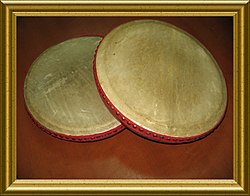 | |
| Percussion instrument | |
|---|---|
| Other names | terbangan |
| Classification | Frame drum |
| Hornbostel–Sachs classification | 211.311 (Directly struck membranophone) |
| Inventor(s) | Javanese |
| Developed | Indonesia |
| Gamelan | |
|---|---|
 Gamelan musical instrument | |
| Country | Indonesia |
| Domains | Traditional craftsmanship, oral traditions and expressions, performing arts, knowledge and practices concerning nature and the universe, social practices, rituals and festive events |
| Reference | 01607 |
| Region | Asia and the Pacific |
| Inscription history | |
| Inscription | 2021 (16th session) |
| List | Representative List |
 Gamelan variations consist of: Javanese gamelan (gamelan jawa) of Central Java and Special Region of Yogyakarta, Balinese gamelan (gamelan bali) of Bali, Sundanese gamelan (gamelan sunda) of West Java, Madurese gamelan (gamelan madura) and Banyuwangian Gamelan (gamelan banyuwangi) of East Java, Gendang beleq of West Nusa Tenggara, Banjarese gamelan (gamelan banjar) of South Kalimantan, Gamelan peking of Lampung, and Talempong of West Sumatra. Gamelan instruments: slab-type (wilahan) instruments (saron/sarun/pemade, demung/sarun ganal, Gendèr/kiliningan, slenthem/selentem/jegogan, peking/sarun paking/kantilan, kecrek/keprak), gong-type (pencon) instruments (gong, kempul, kenong, bonang, trompong, kethuk, talempong, kempyang), String instruments (siter, celempung, kecapi, rebab), Bamboo instrument (suling), Drums instruments (kendhang, Bedug, ketipung, gendang beleq), Wooden instrument (gambang) Idiophone instrument (kemanak) | |
Kompang (Balinese: ᬓᭀᬫ᭄ᬧᬂ; Javanese: ꦏꦺꦴꦩ꧀ꦥꦁ, Javanese pronunciation: [ˈkɔmˈpaːŋ]) is a traditional Balinese and Javanese musical instrument part of gamelan in the percussion family originated from the Indonesian region of Ponorogo in East Java.[1][2] Kompang has existed in Indonesia since at least the 8th century and has spread to various regions of Indonesia as well as the Southeast Asia in general, such as Singapore, Malaysia, Brunei and Thailand, which later became known as Kompang Jawa.[3]
Since 2011, several types of Kompang have been recorded and recognized by the Ministry of Education, Culture, Research, and Technology as National Intangible Cultural Heritage of Indonesia.[4] And in 2021, the United Nations Educational, Scientific and Cultural Organization or what is often known as UNESCO has designated Gamelan (a set of musical instruments that includes Kompang) as an Intangible Cultural Heritage from Indonesia.[5]
- ^ Dr. Febri Yulika, M. Hum (2016), "JEJAK SENI DALAM SEJARAH ISLAM", Dr. Febri Yulika, ISBN 9786021758892
- ^ "Rebana AsliPonorogo Terkenal di Mancanegara".
- ^ "TKisah Petualangan Kyai Zainal Abidin Tegalsari ke Selangor dan Perjuangan Kyai Muhammad bin Umar Banjarsari". JAringan Santri (in Indonesian). 2021.
- ^ "Kompang". Cultural Heritage, Ministry of Education and Culture of Indonesia.
- ^ "Gamelan". UNESCO. Retrieved 18 December 2021.
